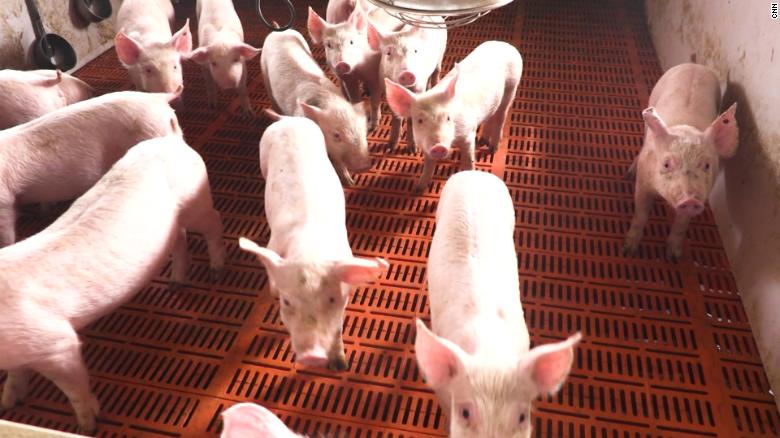Dumplings without pork? Swine fever is hitting Chinese consumers

Pork in China now costs nearly 70% more than it did a year ago, according to data released Tuesday by China’s National Bureau of Statistics. The surge was so dramatic that it pushed up Chinese inflation to 3% in September, from 2.8% the previous month. The damage that African swine fever has wrecked on China’s pig population is hard to overstate. The country is home to half of all the pigs on the planet, and its herd has shrunk by around 130 million since the outbreak began about 13 months ago, according to a CNN Business analysis of data from the Chinese agricultural ministry. Many farmers are reluctant to restock pigs after they are slaughtered, fearing they’ll catch the disease. The swine fever has created a headache for a country where pork is a staple of the diet. Pork makes up around 70% of China’s total meat consumption, according to official data for 2018. On average, a person in China eats 20 kilograms of pork each year.Put another way, that’s about a hamburger’s worth of pork every day. Pork has been important to Chinese cuisine for hundreds of years. It’s widely used in many famous dishes, including braised Dongpo pork and twice-cooked pork. Pork is also the main filling used in dumplings, a signature Chinese dish. ]]]]>]]>The skyrocketing prices haven’t gone unnoticed by consumers, who complain often on social media about how expensive pork has become. Some people have said the hikes are forcing them to become vegetarians. One Weibo user even suggested that the meat is more valuable than a top-of-the-line smartphone. The price of pork has nearly doubled in some regions over the past couple of years. Pork retailed for about 32 yuan ($4.5) per kilogram in 2017, according to government data. Now it’s selling for more than 60 yuan ($8.45) for the same amount in many places.Drastic government measuresChina has been subsidizing pork to some extent. From April to mid-September, the government gave out about 3.2 billion yuan ($452 million) in cash to low-income families so they could continue to afford eating pork. Government officials have even toured the country to talk with people about the scarcity of pork, which could undermine social stability if left unaddressed. This week, Chinese state media reported that Premier Li Keqiang visited a street food vendor in the western city of Xi’an. The vendor said the shop had to increase burger prices because of rising pork costs. The country has taken other drastic steps to solve the problem, too. Last month, for example, it auctioned off 30,000 metric tons of frozen pork from its central reserves to stabilize prices. Some pig farmers have even been raising fatter pigs as a way to produce more meat from a single animal. Jiangxi Zhengbang Technology said last month that it would breed pigs that weigh 150 kilograms before slaughtering them, up to 25% heavier than the average.Another pig farmer, Xiangyang Zhengda, recently imported about 900 pigs — worth nearly $3 million — from Denmark to up its supply, according to China’s commerce ministry. It’s the first time since the crisis began that China has imported live pigs. China has also been buying more pig meat from the rest of the world to keep its consumers happy. The country imported more than 1.3 million tons of pork in the first nine months of 2019, a 44% spike compared to a year ago, according to customs data published Monday. Imports of beef were up more than 50%, as people substitute that meat for pork in their diets.The pig crisis also might be having an influence over how China approaches trade tensions with the United States, too. US President Donald Trump said last week that the two sides reached a preliminary trade truce that will include a commitment from China to buy US agricultural products — something China already suggested it was open to doing. Before the trade war began, China was one of the biggest markets for US agricultural exports, and pork was a huge part of that relationship. The future of pork in ChinaAnalysts, meanwhile, warn that the price hikes aren’t over yet. Rabobank, a Dutch bank specializing in food and farm finance, expects the cost of pork to rise even more as the country prepares for Chinese New Year, which kicks off at the end of January. That could force some customers to change their diets, at least for a little while.The Weibo complaints about cutting pork out of the daily Chinese diet might have some substance behind them, too. Ting Lu, managing director and chief China economist for Nomura, said there could be a short-term change in how Chinese people eat because of the pork crisis. ]]]]>]]>”People could turn to less expensive meat alternatives, such as chicken. Consumption for beef and mutton could also increase as winter comes,” Lu told CNN Business.But he said the swine fever probably won’t change things in the long run. After all, he said, pork has been a traditional staple of the Chinese diet for generations.”Can you imagine the pork used in most Chinese dumplings replaced with something else?” Lu asked. “Once the swine fever gets under control and pork prices pull back, people will eat pork again. Even after two or three years. This is a tradition. It’s powerful.”





